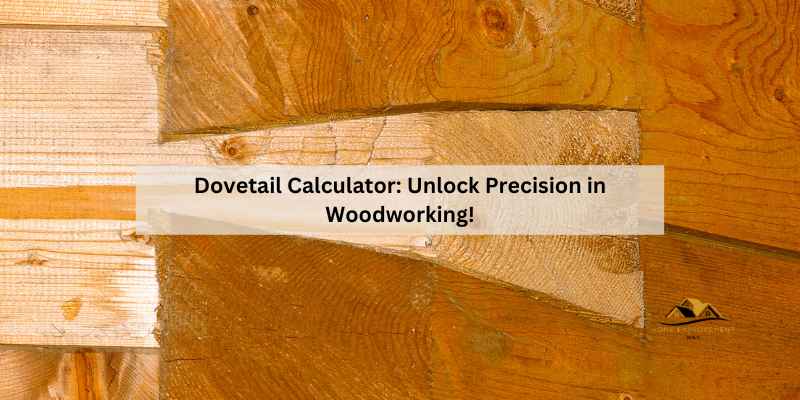A Dovetail Calculator helps woodworkers determine the precise measurements for dovetail joints. It simplifies the process by calculating angles, spacing, and dimensions based on input parameters.
Dovetail joints are a hallmark of fine woodworking, known for their strength and aesthetic appeal. Whether you’re a hobbyist or a seasoned craftsman, achieving perfect dovetails can be challenging. A Dovetail Calculator takes the guesswork out of the equation, allowing you to input specific measurements such as board width and angle.
This tool generates accurate calculations, ensuring your joints fit seamlessly. By utilizing a Dovetail Calculator, you save time and enhance the quality of your projects. Understanding how to use this tool effectively can elevate your woodworking skills and lead to more professional results.
The Essence Of Precision In Woodworking
Dovetail joints are essential for achieving strong and beautiful connections in woodworking. These joints provide both strength and an attractive look to furniture. Accurate measurements are crucial for creating precise dovetail joints.
Each dovetail joint consists of two parts: pins and tails. The design and fit of these pieces directly impact the joint’s strength. Using a dovetail calculator can help simplify this process, allowing woodworkers to focus on craftsmanship.
Measuring correctly ensures that each joint fits snugly. A well-measured joint minimizes gaps and enhances durability. Mistakes in measurement can lead to weak connections and wasted materials.
Utilizing tools like a dovetail calculator not only saves time but also improves the quality of the final product. Therefore, investing time in learning about dovetail joints and their measurements is beneficial.
Exploring Dovetail Calculators
Dovetail calculators are essential tools for woodworkers. They simplify the measuring and designing of dovetail joints. By inputting specific dimensions, users quickly receive accurate measurements. This process reduces guesswork and enhances precision.
Understanding how these calculators work is straightforward. Users input data such as board width, pin angle, and number of pins. The calculator then processes the information and provides instant results.
Benefits of using a dovetail calculator are numerous. It saves time by eliminating tedious calculations. Users can achieve consistent results with ease. This tool also helps in creating professional-quality joints. Overall, it enhances the woodworking experience significantly.
Key Features Of Dovetail Calculators
Dovetail calculators offer a user-friendly interface. This makes it easy for anyone to use. Clear buttons and simple layouts enhance the experience. Users can quickly find what they need without confusion.
These tools are compatible with various devices. Whether on a computer, tablet, or smartphone, accessing the calculator is seamless. Different screen sizes do not affect usability. This flexibility ensures that woodworkers can calculate dovetails anytime, anywhere.
Finding The Perfect Dovetail Ratio
Understanding dovetail ratios is crucial for woodworkers. Traditional ratios often favor a 1:6 or 1:8 slope. These ratios provide a balance of strength and aesthetics. On the other hand, modern ratios may lean towards a steeper angle, like 1:5. This choice can enhance the visual appeal of the joint.
The impact of these ratios affects both joint strength and overall appearance. A traditional ratio offers more interlocking surface area. This results in a stronger joint. However, modern ratios may look more sleek and contemporary. Woodworkers should consider the project’s style and functionality when choosing a ratio.
Spacing Dovetails For Optimum Results
Spacing dovetails correctly is crucial for strength and appearance. Standard guidelines suggest maintaining a distance of 1/4 inch between dovetails. This spacing works well for most projects, ensuring durability and a neat look.
Customizing spacing is essential for unique projects. Consider using wider spaces for larger pieces and narrower spaces for smaller items. This approach allows for better visual balance and structural integrity.
Always measure the wood thickness before deciding on spacing. Adjustments can lead to a more personalized design. Experimentation may yield the most appealing results for your specific project.
Step-by-step: Using A Dovetail Calculator
To use a Dovetail Calculator, start by inputting your measurements. Enter the board width, pin board thickness, and other necessary dimensions. Ensure you double-check each value for accuracy.
After entering the measurements, click on the calculate button. The calculator will display the results based on the provided data. This includes the number of pins, pin width, and angle. Review these results carefully to understand how they affect your dovetail joint.
Understanding the output helps in making adjustments. If the results seem off, recheck your measurements. Accurate inputs lead to the best outcomes.
Common Pitfalls And How To Avoid Them
Measurement errors often lead to poor dovetail joints. Always double-check your measurements before cutting. Use a reliable ruler or caliper for precision. Small mistakes can cause big problems.
Tool calibration is essential for accuracy. Ensure your tools are properly set up and functioning well. Regularly check your saws and chisels for any wear. A well-calibrated tool helps achieve perfect dovetails.
Using a dovetail calculator can minimize errors. Input your dimensions carefully to get accurate results. This tool simplifies the process and saves time.
Beyond The Calculator: Tips For Perfect Dovetails
Mastering hand cutting techniques for dovetails takes practice and patience. Start with a sharp chisel and a fine saw for precise cuts. Always mark your wood clearly before cutting. This ensures accuracy and helps avoid mistakes.
Dovetail templates can significantly enhance your cutting process. They provide a visual guide for angles and spacing. Using templates allows for consistent measurements, making your dovetails look professional. You can create templates from cardboard or purchase them online.
Practice on scrap wood to refine your skills. Focus on achieving tight joints for better strength. With time, your ability to hand cut dovetails will improve, resulting in beautiful woodworking projects.
Advanced Features For The Avid Woodworker
Incorporating graduated dovetails can add a unique touch to woodworking projects. This technique creates a staggered look that enhances the beauty of joints. Start by marking the largest dovetail at the bottom. Gradually reduce the size as you move upward. This method works well for drawers and cabinetry.
Exploring variations in dovetail layouts opens up endless possibilities. Traditional dovetails feature straight lines, while angled designs provide a modern twist. Experiment with different spacings between dovetails for a customized appearance. Use a dovetail calculator to ensure precision in measurements.
| Feature | Description |
|---|---|
| Graduated Dovetails | Creates a staggered look by varying sizes. |
| Angled Designs | Offers a modern twist to traditional dovetails. |
| Spacing Variations | Customizes the appearance with different distances. |
Resources And Communities For Woodworking Enthusiasts
Online forums and discussions are great for woodworking enthusiasts. Many communities share tips and tricks. Popular platforms include Reddit and specialized woodworking sites. Here, members discuss dovetail techniques and share experiences. Questions about tools and materials are also common.
Workshops and educational resources offer hands-on learning. Local woodworking clubs often host events. Many online platforms provide video tutorials and courses. Websites like YouTube have numerous channels dedicated to woodworking. These resources help improve skills and boost confidence.
| Resource Type | Examples |
|---|---|
| Online Forums | Reddit, Woodworking Talk |
| Workshops | Local clubs, Community centers |
| Educational Websites | Popular Woodworking, Katz-Moses Tools |
Frequently Asked Questions
What Is The Formula For Measuring Dovetails?
To measure dovetails, use the formula: D = W / N, where D is the tail width, W is the board width, and N is the number of tails. Adjust the angle for slope as needed. This ensures precise and symmetrical dovetail joints.
What Is The Best Ratio For Dovetails?
The best ratio for dovetails typically ranges from 1:6 to 1:8. A 1:7 ratio is commonly preferred for a balance between strength and aesthetic appeal. Adjust the ratio based on wood thickness and project requirements for optimal results.
What Angle Is A 1 In 8 Dovetail?
A 1 in 8 dovetail has an angle of approximately 7. 125 degrees. This angle is commonly used for traditional woodworking joints, providing a strong and secure fit. Understanding this measurement aids in achieving precise cuts and effective joints.
How Far Apart Should Dovetails Be?
Dovetails should typically be spaced about 1 to 1. 5 times the thickness of the stock. For example, if using 3/4-inch material, space them 3/4 to 1 inch apart. Adjust based on the project’s design and aesthetic preferences. Consistency ensures a professional appearance.
Conclusion
Utilizing a dovetail calculator streamlines your woodworking projects. It simplifies complex measurements, ensuring accuracy and efficiency. Whether you’re a beginner or an experienced woodworker, this tool enhances your craftsmanship. Embrace technology to achieve perfect dovetail joints every time. Start calculating today for flawless results in your next woodworking endeavor!

